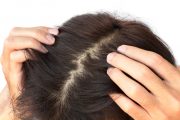You know you want healthy, strong, lovely hair but you don’t know how to care for it? We have crafted this guide for women like you. The women that are now beginning their hair-care adventure. Learn to care for your hair step by step.

Without drawing up a plan you can’t condition your hair. The overload of products, treatments and possibilities make it hard for us to choose the right way. How not to get lost in the flood of information? How to take a path leading you straight to healthy, amazing hair? See our guide for beginners.
Define your hair problems and goals
First things first: answer two big questions that will enable you to suit the hair care to your needs.
- What’s your hair problem?
Frizz, dullness, split ends, lack of volume, dandruff? - What hair do you dream of?
Silky smooth, easier to comb, curly or super-straight?
Define these two things and strive for the goal! Eliminate the problems that make your hair look worse. This is the easiest way to achieve the dream hair look. Just remember that there are some limitations – if your hair is naturally fine, you can’t make it ten times thicker all of a sudden.
Define your hair type
Defining the hair type makes another big step. You must know your hair type to choose the right products. It’s impossible to care for the hair not knowing its type and needs.
The criteria to consider include:
- condition of hair: dry, normal, oily, damaged
- thickness/density: fine, thick, thin, dense
- texture: straight, wavy, curly, coily, ect.
- porosity: low, medium, high
Why is it so important to know one’s hair type? Above all else, different types need different products. For example, dry strands need hydration delivered by humectant-rich products while damaged hair cries for proteins. As far as the porosity goes, it tells you how fast your hair absorbs nutrients and water.
Define your scalp type
Have you ever chosen a shampoo that goes with the skin on your head? We guess you haven’t. This is one of the top mistakes, causing dryness and irritations. Remember to pick the right products for your scalp too because this is what determines the condition of your hair. If the skin is dry, get a hydrating product. If it’s easily irritated, get a dermatologist-approved formulation. If you suffer from seborrheic dermatitis, ask your doctor for medication.
Analyze your past hair-care routine
It’s time you took a closer look at your past hair-care choices. What products did you use? Which ones made your hair “feel” better or react with frizz? Try to remember all good and bad moments that your hair has experienced. Draw the conclusions and judge what makes your hair better and what makes it worse. This “time travel” gives you a better perspective on your hair care. You may be surprised by the number of mistakes you used to make but always treat them like a lesson you can learn from. Do things better next time.
Read, learn, get inspired
You can’t become a hair expert right away. You can’t expect to know everything about hair care without studying. Where to seek the information on the best hair care then? There are some possibilities:
- follow bloggers who have similar hair and get inspired by the products and methods they use.
- read articles on hair-care blogs and forums to get the lowdown.
- talk to your hairdresser whenever possible (e.g. when getting hair trimmed).



